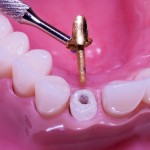
The restoration of teeth following root canal treatment (RoCT) can present challenges and posts inserted into the root canal can provide support to enable restoration. The aim of this study was to evaluate the survival of glass fibre and cast metal posts used to restore endodontically treated teeth with no remaining coronal wall.
Patients with good oral health with one or more endodontically treated anterior or posterior teeth with no coronal wall or the enamel portion of one wall with no dentinal support (ferrule height, 0–0.5 mm) requiring intra-radicular retention and a single metal-ceramic crown were recruited. They were randomised to cast or glass fibre posts a second randomization was performed to determine whether regular or self-adhesive resin cement would be used.
All treatment was carried out under rubber dam. RoCT was carried out using a crown down technique and irrigation with 2.5% NaOCl solution. A lateral condensation technique was used to obturate the canal. 2/3 of the filling was removed from the root canal before post cementation. All teeth were restored with single metal-ceramic crowns. Patients were recalled at 6, 12, 24, and 36 months for clinical and radiographic examinations.
- Of the 64 patients randomised 3 did not proceed, 6 were lost to follow up.
- 72 posts in 40 anterior and 32 posterior teeth (37 glass fibre posts in 21 anterior and 16 posterior teeth; 35 cast metal posts in 19 anterior and 16 posterior teeth) were evaluated.
- The mean observation times were 19.2 ± 7.84 months for glass fibre posts and 15.02 ±7.04 months for cast metal posts.
- Seventy-two teeth were evaluated at 6 months, 53 at 12 months, and 26 teeth at 36 months.
- There were 4 failures: 2 glass fibre posts in a premolar and anterior tooth debonded, one glass fibre post in a premolar debonded in association with root fracture, and one root fracture occurred in a molar with a cast metal post
- Survival rates of glass fibre and cast metal posts were similar (97.1% and 91.9%, respectively; p = 0.682).
The authors concluded
After 3 years of follow up, glass fibre and cast metal posts showed good and similar clinical performance, regardless of tooth location.
Comment
A Cochrane review of post systems was conducted in 2007 by Bolla et al. They only included two trails which did not provide enough evidence to recommend which post system should be used. Since then more studies have become available as well as a review of in-vitro studies. (Dental Elf 14th Jan 2013). This new study provides some additional information while the recall rate is indicated to be 92.3% at 3 years, 73% of the teeth had been observed to 12 months and only 36% for three years.
Links
Sarkis-Onofre R, de Castilho Jacinto R, Boscato N, Cenci MS, Pereira-Cenci T. Cast metal vs. glass fibre posts: A randomized controlled trial with up to 3 years of follow up. J Dent. 2014 Feb 12. pii: S0300-5712(14)00042-6. doi: 10.1016/j.jdent.2014.02.003. [Epub ahead of print] PubMed PMID: 24530920.
Bolla M, Muller-Bolla M, Borg C, Lupi-Pegurier L, Laplanche O, Leforestier E. Root canal posts for the restoration of root filled teeth. Cochrane Database of Systematic Reviews 2007, Issue 1. Art. No.: CD004623. DOI: 10.1002/14651858.CD004623.pub2.

[…] Dental Elf – 28th Feb 2014 -Trail suggests similar outcomes with cast and glass fibre posts […]